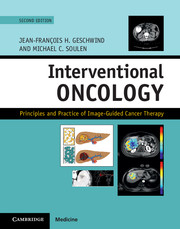Book contents
- Frontmatter
- Contents
- List of contributors
- Section I Principles of oncology
- Section II Principles of image-guided therapies
- Section III Organ-specific cancers – primary liver cancers
- Section IV Organ-specific cancers – liver metastases
- Section V Organ-specific cancers – extrahepatic biliary cancer
- Section VI Organ-specific cancers – renal cell carcinoma
- Section VII Organ-specific cancers – chest
- Section VIII Organ-specific cancers – musculoskeletal
- Section IX Organ-specific cancers – prostate
- Section X Specialized interventional techniques in cancer care
- 28 Vascular access: Venous and arterial ports
- 29 Palliative care and symptom management
- 30 CT-guided neurolysis for cancer-related abdominal and pelvic pain
- 31 Palliative procedures for ascites and effusion
- Index
- References
29 - Palliative care and symptom management
from Section X - Specialized interventional techniques in cancer care
Published online by Cambridge University Press: 05 September 2016
- Frontmatter
- Contents
- List of contributors
- Section I Principles of oncology
- Section II Principles of image-guided therapies
- Section III Organ-specific cancers – primary liver cancers
- Section IV Organ-specific cancers – liver metastases
- Section V Organ-specific cancers – extrahepatic biliary cancer
- Section VI Organ-specific cancers – renal cell carcinoma
- Section VII Organ-specific cancers – chest
- Section VIII Organ-specific cancers – musculoskeletal
- Section IX Organ-specific cancers – prostate
- Section X Specialized interventional techniques in cancer care
- 28 Vascular access: Venous and arterial ports
- 29 Palliative care and symptom management
- 30 CT-guided neurolysis for cancer-related abdominal and pelvic pain
- 31 Palliative procedures for ascites and effusion
- Index
- References
Summary
Palliative care and communication with cancer patients
Overview of palliative care
The World Health Organization defines palliative care as an approach that improves the quality of life of patients and their families facing the problems associated with life-threatening illness, through the prevention and relief of suffering by means of early identification and impeccable assessment and treatment of pain and other problems, physical, psychosocial, and spiritual. Palliative care is focused on symptom relief and maximizing function, without necessarily impacting the natural history of the underlying illness. Bereavement support is integral to its mission as it views the patient and his or her loved ones as a unit of care. Palliative care is interdisciplinary, involving not only nurses and physicians, but chaplains, psychologists, social workers, and speech, physical, occupational, and other therapists. While palliative care has historic roots in the terminal care of cancer patients, its scope encompasses a wide variety of patients with non-malignant diseases. These include neurodegenerative disorders; advanced organ disease; and patients in critical care units. Ideally, palliative care is provided to patients with severe illnesses early in the course of their disease, alongside disease-modifying or curative therapy. As an illness progresses, and as disease-modifying or even life-prolonging interventions become less available, a patient's entire care may become palliative-focused. While much of the care of patients with life-threatening illness can be described as palliative, many patients will not require specialist palliative care, and basic competency in palliative care is important for clinicians across a variety of specialties and practice types.
Palliative medicine describes the physician's role in the aforementioned care model. Besides expert symptom assessment and treatment, palliative medicine physicians offer subspecialty expertise in determining prognosis and communication encounters with patients and families involving breaking bad news, establishing goals of medical care, and planning for the future in light of a life-threatening illness. The scope of practice of palliative medicine physicians varies by location and institution. Common settings include inpatient consultative palliative care services, acute inpatient palliative care wards, outpatient palliative care clinics, cancer pain and symptom management clinics, emergency departments, nursing home palliative care services, and hospice settings. Palliative care is increasing by number of programs and prevalence among adult and pediatric hospitals such that many cancer care providers will have access to palliative care specialists if needed.
- Type
- Chapter
- Information
- Interventional OncologyPrinciples and Practice of Image-Guided Cancer Therapy, pp. 294 - 314Publisher: Cambridge University PressPrint publication year: 2016



